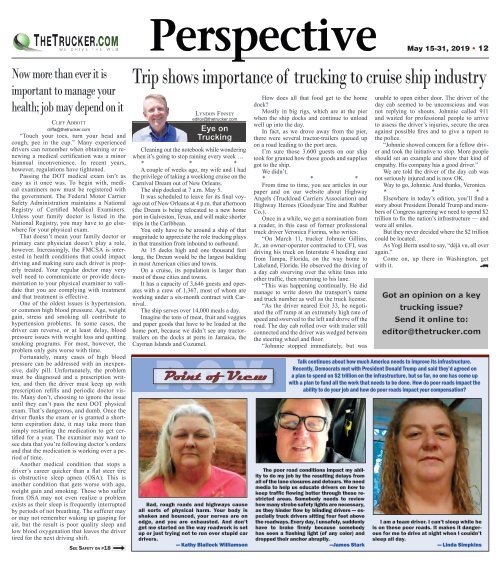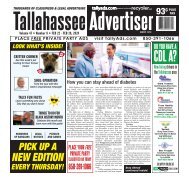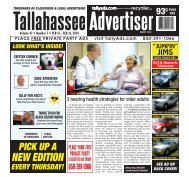TT_051519_AllPages
Create successful ePaper yourself
Turn your PDF publications into a flip-book with our unique Google optimized e-Paper software.
Perspective May<br />
15-31, 2019 • 12<br />
Now more than ever it is<br />
important to manage your<br />
health; job may depend on it<br />
Cliff Abbott<br />
cliffa@thetrucker.com<br />
“Touch your toes, turn your head and<br />
cough, pee in the cup.” Many experienced<br />
drivers can remember when obtaining or renewing<br />
a medical certification was a minor<br />
biannual inconvenience. In recent years,<br />
however, regulations have tightened.<br />
Passing the DOT medical exam isn’t as<br />
easy as it once was. To begin with, medical<br />
examiners now must be registered with<br />
the government. The Federal Motor Carrier<br />
Safety Administration maintains a National<br />
Registry of Certified Medical Examiners.<br />
Unless your family doctor is listed in the<br />
National Registry, you may have to go elsewhere<br />
for your physical exam.<br />
That doesn’t mean your family doctor or<br />
primary care physician doesn’t play a role,<br />
however. Increasingly, the FMCSA is interested<br />
in health conditions that could impact<br />
driving and making sure each driver is properly<br />
treated. Your regular doctor may very<br />
well need to communicate or provide documentation<br />
to your physical examiner to validate<br />
that you are complying with treatment<br />
and that treatment is effective.<br />
One of the oldest issues is hypertension,<br />
or common high blood pressure. Age, weight<br />
gain, stress and smoking all contribute to<br />
hypertension problems. In some cases, the<br />
driver can reverse, or at least delay, blood<br />
pressure issues with weight loss and quitting<br />
smoking programs. For most, however, the<br />
problem only gets worse with time.<br />
Fortunately, many cases of high blood<br />
pressure can be addressed with an inexpensive,<br />
daily pill. Unfortunately, the problem<br />
must be diagnosed and a prescription written,<br />
and then the driver must keep up with<br />
prescription refills and periodic doctor visits.<br />
Many don’t, choosing to ignore the issue<br />
until they can’t pass the next DOT physical<br />
exam. That’s dangerous, and dumb. Once the<br />
driver flunks the exam or is granted a shortterm<br />
expiration date, it may take more than<br />
simply restarting the medication to get certified<br />
for a year. The examiner may want to<br />
see data that you’re following doctor’s orders<br />
and that the medication is working over a period<br />
of time.<br />
Another medical condition that stops a<br />
driver’s career quicker than a flat steer tire<br />
is obstructive sleep apnea (OSA). This is<br />
another condition that gets worse with age,<br />
weight gain and smoking. Those who suffer<br />
from OSA may not even realize a problem<br />
exists as their sleep is frequently interrupted<br />
by periods of not breathing. The sufferer may<br />
or may not remember waking up gasping for<br />
air, but the result is poor quality sleep and<br />
low blood oxygenation that leaves the driver<br />
tired for the next driving shift.<br />
See Safety on p18 m<br />
Trip shows importance of trucking to cruise ship industry<br />
Lyndon Finney<br />
editor@thetrucker.com<br />
Eye on<br />
Trucking<br />
Cleaning out the notebook while wondering<br />
when it’s going to stop raining every week …<br />
* * *<br />
A couple of weeks ago, my wife and I had<br />
the privilege of taking a weeklong cruise on the<br />
Carnival Dream out of New Orleans.<br />
The ship docked at 7 a.m. May 5.<br />
It was scheduled to leave for its final voyage<br />
out of New Orleans at 4 p.m. that afternoon<br />
(the Dream is being relocated to a new home<br />
port in Galveston, Texas, and will make shorter<br />
trips in the Caribbean.<br />
You only have to be around a ship of that<br />
magnitude to appreciate the role trucking plays<br />
in that transition from inbound to outbound.<br />
At 15 decks high and one thousand feet<br />
long, the Dream would be the largest building<br />
in most American cities and towns.<br />
On a cruise, its population is larger than<br />
most of those cities and towns.<br />
It has a capacity of 3,646 guests and operates<br />
with a crew of 1,367, most of whom are<br />
working under a six-month contract with Carnival.<br />
The ship serves over 14,000 meals a day.<br />
Imagine the tons of meat, fruit and veggies<br />
and paper goods that have to be loaded at the<br />
home port, because we didn’t see any tractortrailers<br />
on the docks at ports in Jamaica, the<br />
Cayman Islands and Cozumel.<br />
Bad, rough roads and highways cause<br />
all sorts of physical harm. Your body is<br />
shaken and bounced, your nerves are on<br />
edge, and you are exhausted. And don’t<br />
get me started on the way roadwork is set<br />
up or just trying not to run over stupid car<br />
drivers.<br />
— Kathy Blailock Williamson<br />
How does all that food get to the home<br />
dock?<br />
Mostly in big rigs, which are at the pier<br />
when the ship docks and continue to unload<br />
well up into the day.<br />
In fact, as we drove away from the pier,<br />
there were several tractor-trailers queued up<br />
on a road leading to the port area.<br />
I’m sure those 3.600 guests on our ship<br />
took for granted how those goods and supplies<br />
got to the ship.<br />
We didn’t.<br />
* * *<br />
From time to time, you see articles in our<br />
paper and on our website about Highway<br />
Angels (Truckload Carriers Association) and<br />
Highway Heroes (Goodyear Tire and Rubber<br />
Co.).<br />
Once in a while, we get a nomination from<br />
a reader, in this case of former professional<br />
truck driver Veronica Fiorina, who writes:<br />
“On March 11, trucker Johnnie Gillins,<br />
Jr., an owner-operator contracted to CFI, was<br />
driving his truck on Interstate 4 heading east<br />
from Tampa, Florida, on the way home to<br />
Lakeland, Florida. He observed the driving of<br />
a day cab swerving over the white lines into<br />
other traffic, then returning to his lane.<br />
“This was happening continually. He did<br />
manage to write down the transport’s name<br />
and truck number as well as the truck license.<br />
“As the driver neared Exit 33, he negotiated<br />
the off ramp at an extremely high rate of<br />
speed and swerved to the left and drove off the<br />
road. The day cab rolled over with trailer still<br />
connected and the driver was wedged between<br />
the steering wheel and floor.<br />
“Johnnie stopped immediately, but was<br />
Got an opinion on a key<br />
trucking issue?<br />
Send it online to:<br />
editor@thetrucker.com<br />
Talk continues about how much America needs to improve its infrastructure.<br />
Recently, Democrats met with President Donald Trump and said they’d agreed on<br />
a plan to spend on $2 trillion on the infrastructure, but so far, no one has come up<br />
with a plan to fund all the work that needs to be done. How do poor roads impact the<br />
ability to do your job and how do poor roads impact your compensation?<br />
The poor road conditions impact my ability<br />
to do my job by the resulting delays from<br />
all of the lane closures and detours. We need<br />
media to help us educate drivers on how to<br />
keep traffic flowing better through these restricted<br />
areas. Somebody needs to review<br />
how many strobe safety lights are necessary,<br />
as they hinder flow by blinding drivers — especially<br />
truck drivers sitting four feet above<br />
the roadways. Every day, I unsafely, suddenly<br />
have to brake firmly because somebody<br />
has seen a flashing light (of any color) and<br />
dropped their anchor abruptly.<br />
—James Stark<br />
unable to open either door. The driver of the<br />
day cab seemed to be unconscious and was<br />
not replying to shouts. Johnnie called 911<br />
and waited for professional people to arrive<br />
to assess the driver’s injuries, secure the area<br />
against possible fires and to give a report to<br />
the police.<br />
“Johnnie showed concern for a fellow driver<br />
and took the initiative to stop. More people<br />
should set an example and show that kind of<br />
empathy. His company has a good driver.”<br />
We are told the driver of the day cab was<br />
not seriously injured and is now OK.<br />
Way to go, Johnnie. And thanks, Veronica.<br />
* * *<br />
Elsewhere in today’s edition, you’ll find a<br />
story about President Donald Trump and members<br />
of Congress agreeing we need to spend $2<br />
trillion to fix the nation’s infrastructure — and<br />
were all smiles.<br />
But they never decided where the $2 trillion<br />
could be located.<br />
As Yogi Berra used to say, “déjà vu, all over<br />
again.”<br />
Come on, up there in Washington, get<br />
with it. 8<br />
I am a team driver. I can’t sleep while he<br />
is on these poor roads. It makes it dangerous<br />
for me to drive at night when I couldn’t<br />
sleep all day.<br />
— Linda Simpkins

















